The 4th Industrial Revolution

A BRIEF HISTORY OF THE INDUSTRIAL REVOLUTION
Industrial revolution is defined as the changes in manufacturing and transportation that began with fewer things being made by hand but instead made using machines in larger-scale factories.
In the late 18th century everyday life was transformed by the industrial revolution. Towns, industry and trade had been growing for centuries but about 1780 economic growth took off. The industrial revolution meant a much higher standard of living for ordinary people. Britain became much richer as a result of it.
The first industrial revolution – 1765
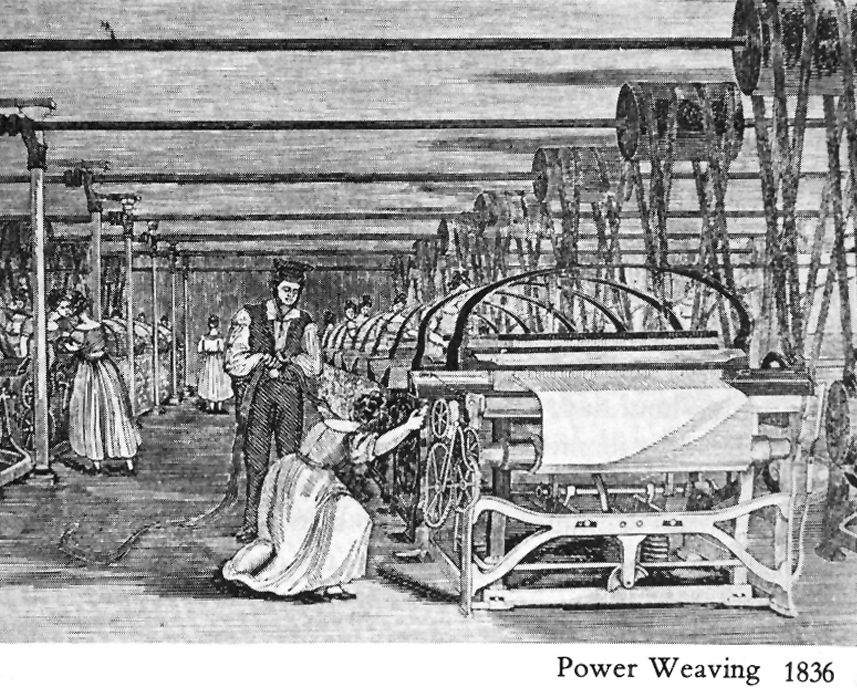
Following a slow period of proto-industrialization, this first revolution spans from the end of the 18th century to the beginning of the 19th century. It witnessed the emergence of mechanization, a process that replaced agriculture with industry as the foundations of the economic structure of society. Mass extraction of coal along with the invention of the steam engine created a new type of energy that thrusted forward all processes thanks to the development of railroads and the acceleration of economic, human and material exchanges. Other major inventions such as forging and new know-how in metal shaping gradually drew up the blueprints for the first factories and cities as we know them today.
The second industrial revolution – 1870
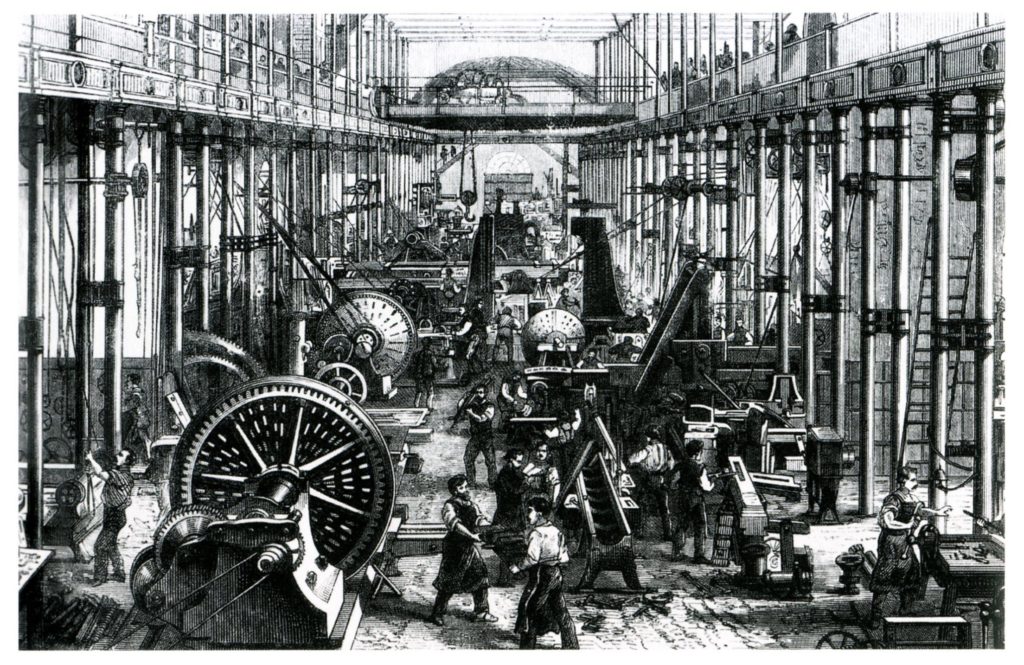
Nearly a century later at the end of the 19th century, new technological advancements initiated the emergence of a new source of energy: electricity, gas and oil. As a result, the development of the combustion engine set out to use these new resources to their full potential. Furthermore, the steel industry began to develop and grow alongside the exponential demands for steel. Chemical synthesis also developed to bring us synthetic fabric, dyes and fertilizer. Methods of communication were also revolutionized with the invention of the telegraph and the telephone and so were transportation methods with the emergence of the automobile and the plane at the beginning of the 20th century. All these inventions were made possible by centralizing research and capital structured around an economic and industrial model based on new “large factories” and the organizational models of production as envisioned by Taylor and Ford.
The third industrial revolution – 1969

Nearly a century later, in the second half of the 20th century, a third industrial revolution appeared with the emergence of a new type of energy whose potential surpassed its predecessors: nuclear energy. This revolution witnessed the rise of electronics—with the transistor and microprocessor—but also the rise of telecommunications and computers. This new technology led to the production of miniaturized material which would open doors, most notably to space research and biotechnology. For industry, this revolution gave rise to the era of high-level automation in production thanks to two major inventions: automatons—programmable logic controllers (PLCs)—and robots.
The first industrial revolution used water and steam to mechanize production, the second used electric energy to create mass production and the third used electronics and information technology to automate production. Today a fourth industrial revolution is underway which builds upon the third revolution and the digital revolution that has been taking place since the middle of the last century. This fourth revolution with exponential expansion is characterized by merging technology that blurs the lines between the physical, digital and biological spheres to completely uproot industries all over the world. The extent and depth of these changes are a sign of transformations to entire production, management and governance systems.
Industry 4.0 Industrial Revolution
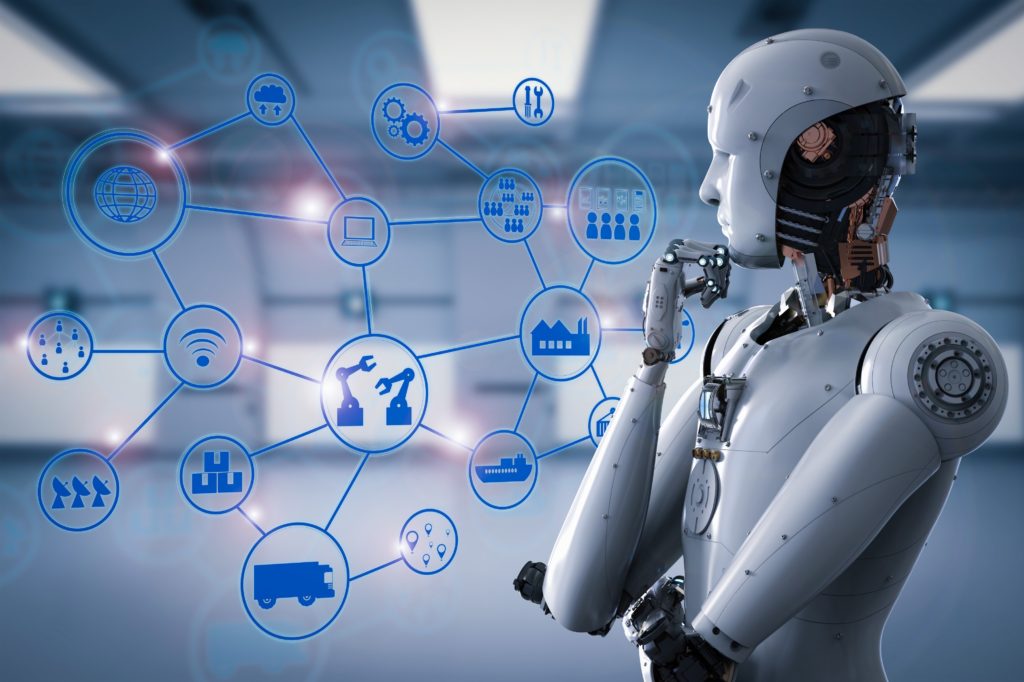
Here we are…the fourth revolution is unfolding before our eyes. Its genesis is situated at the dawn of the third millennium with the emergence of the Internet. This is the first industrial revolution rooted in a new technological phenomenon—digitalization—rather than in the emergence of a new type of energy. This digitalization enables us to build a new virtual world from which we can steer the physical world.
The industry of today and tomorrow aim to connect all production means to enable their interaction in real time. Factories 4.0 make communication among the different players and connected objects in a production line possible thanks to technology such as Cloud, Big Data Analytics and the Industrial Internet of Things.
The applications for the industrial sector are already enormous: predictive maintenance, improved decision-making in real time, anticipating inventory based on production, improved coordination among jobs, etc. Day after day, all these improvements are gradually optimizing production tools and revealing endless possibilities for the future of industry 4.0, the crossroads for an interconnected global system.
However, this fourth industrial revolution could be the first to deviate from the energy-greed trend—in terms of nonrenewable resources—because we have been integrating more and more possibilities to power our production processes with alternative resources. Tomorrow, factories 4.0 will be embedded in smart cities and powered by wind, sun and geothermal energy.
Within this context of profound technological and societal changes—because the two always go hand in hand during industrial revolutions—which is taking us towards global digitalization, industrial cybersecurity will become a leading sector. Positioned at the heart of this sector, Sentryo is proud to be seen as pioneers.
Technology in the Industrial Revolution
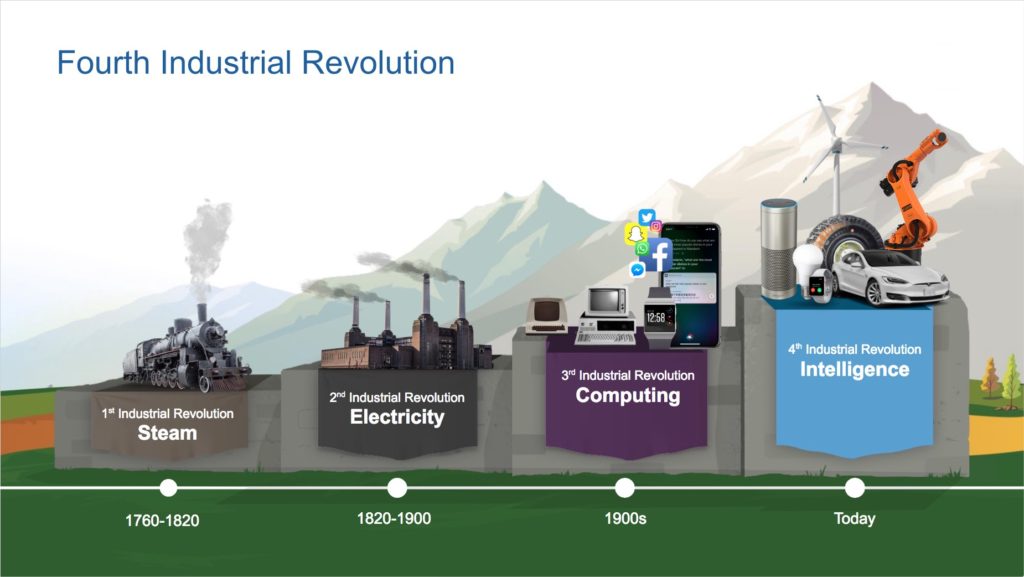
A number of technological advances made the industrial revolution possible. In 1709 Abraham Darby (1677-1717), who owned an ironworks, began using coke instead of charcoal to melt iron ore. (It was a much more efficient fuel). Darby and his family kept the new fuel secret for a time but in the late 18th century the practice spread.
From 1712 Thomas Newcomen made steam engines to pump water from coal mines. Then, in 1769, James Watt patented a more efficient steam engine and in the 1780s it was adapted to power machinery. The first industry to become mechanised was the textile industry. In 1771 Richard Arkwright opened a cotton-spinning mill with a machine called a water frame, which was powered by a water mill. Then, in 1779, Samuel Crompton invented a new cotton-spinning machine called a spinning mule. Finally in 1785 Edmund Cartwright invented a loom that could be powered by a steam engine. As a result of these new inventions, cotton production boomed.
Iron production also grew rapidly. In 1784 a man named Henry Cort (1740-1800) invented a much better way of making wrought iron. Until then men had to beat red hot iron with hammers to remove impurities. In 1784 Cort invented the puddling process. The iron was melted in an extremely hot furnace and stirred of ‘puddled’ to remove impurities. The result was a vast increase in iron production.
In the 19th century people mastered electricity. In 1819 a Dane, Hans Christian Oersted discovered that electric current in a wire caused a nearby compass needle to move. The Englishman Michael Faraday (1791-1867) invented the dynamo. In 1837 Samuel Morse invented the electric telegraph. In 1876 Alexander Graham Bell invented the telephone. In 1878 Joseph Swan invented the light bulb.
Work during the Industrial Revolution
However the technological changes of the late 19th century and the early 19th century did not necessarily make life more comfortable or easier for ordinary people. On the contrary, in the early 19th century people had to work in dreadful conditions. However, as the century progressed these gradually got better. During the 19th century, the factory system gradually replaced the system of people working in their own homes or in small workshops. In England, the textile industry was the first to be transformed. When children worked in textile factories they often worked for more than 12 hours a day.
In the early 19th century parliament passed laws to curtail child labor. However, they all proved to be unenforceable. The first effective law was passed in 1833. It was effective because for the first time factory inspectors were appointed to make sure the law was being obeyed. The new law banned children under 9 from working in textile factories. It said that children aged 9 to 13 must not work for more than 12 hours a day or 48 hours a week. Children aged 13 to 18 must not work for more than 69 hours a week. Furthermore, nobody under 18 was allowed to work at night (from 8.30 pm to 5.30 am). Children aged 9 to 13 were to be given 2 hours of education a day.
Conditions in coal mines were also terrible. Children as young as 5 worked underground. In 1842 a law banned women and boys under 10 from working underground. In 1844 a law banned all children under 8 from working. Then in 1847, a Factory Act said that women and children could only work 10 hours a day in textile factories. In 1867 the law was extended to all factories. (A factory was defined as a place where more than 50 people were employed in a manufacturing process). In 1878 an act said that women could not work more than 56 hours a week in any factory.
In the 19th century boys were made to climb up chimneys to clean them. This barbaric practice was ended by law in 1875. In the 1850s and 1860s, skilled craftsmen formed national trade unions. In 1868 a group of them formed the TUC. However unskilled workers did not become organised until the late 1880s.
A history of work
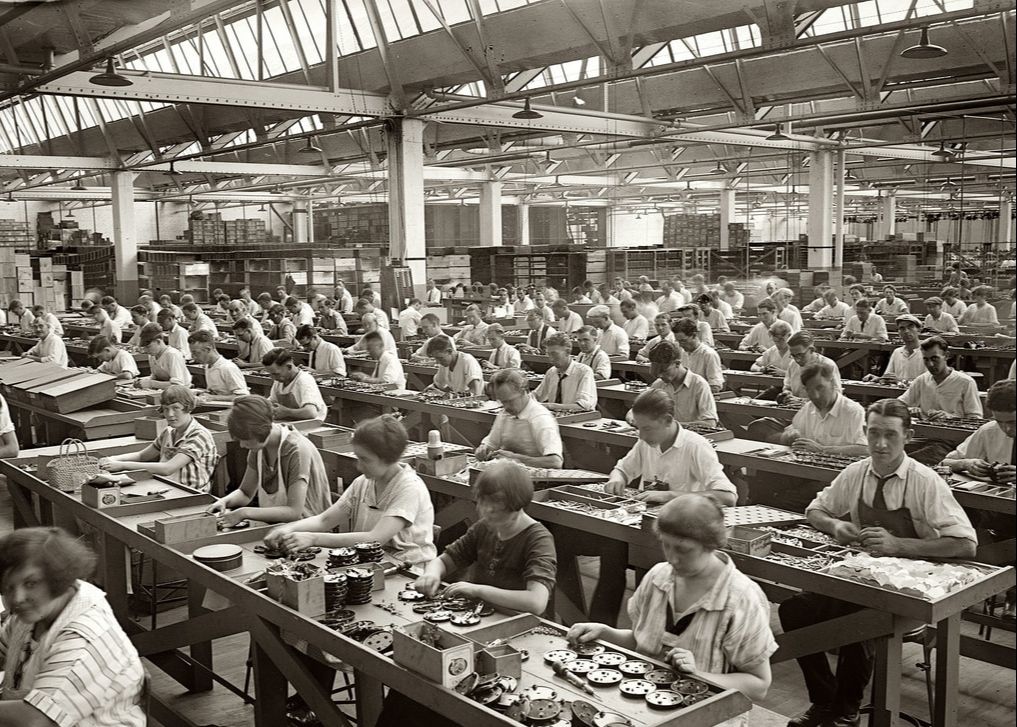
Towns and cities during the Industrial Revolution
At first the industrial revolution did not mean better living conditions for ordinary people. In the late 18th century and early 19th century, many villages or small market towns rapidly grew into industrial cities. However, although most towns gained gas light in other ways conditions were appalling. They were dirty, overcrowded and unsanitary. Lack of building regulations meant poor peoples houses were often hovels. Not surprisingly British towns suffered outbreaks of cholera in 1832 and in 1848.
However in the late 19th century things improved. Most towns built sewers and created a clean water supply. New housing regulations meant that new houses were much better. Furthermore, public parks and public libraries were created. At the end of the 19th century and the beginning of the 20th most towns changed to electric street lighting. Meanwhile, in 1842, Joseph Whitworth invented the mechanical street sweeper.
At the end of the 19th century transport was improved. From c.1880 horse drawn trams ran in the streets of many towns. At the beginning of the 20th century, they were replaced by electric trams. In the 1930s most trams were replaced by trolley buses (buses that ran on overhead lines). However, by the late 1950s, most trolley buses had been replaced by motor buses.
Meanwhile a new kind of town had arisen – the seaside town. At the end of the 18th century spending time by the sea became fashionable with the wealthy. At first, only they could afford it but from the mid-19th century trains made it easier for poorer people to reach the seaside. In 1871 bank holidays were introduced and some skilled workers paid annual holidays. That made the day at the seaside popular and many resorts boomed.
Homes during the Industrial Revolution
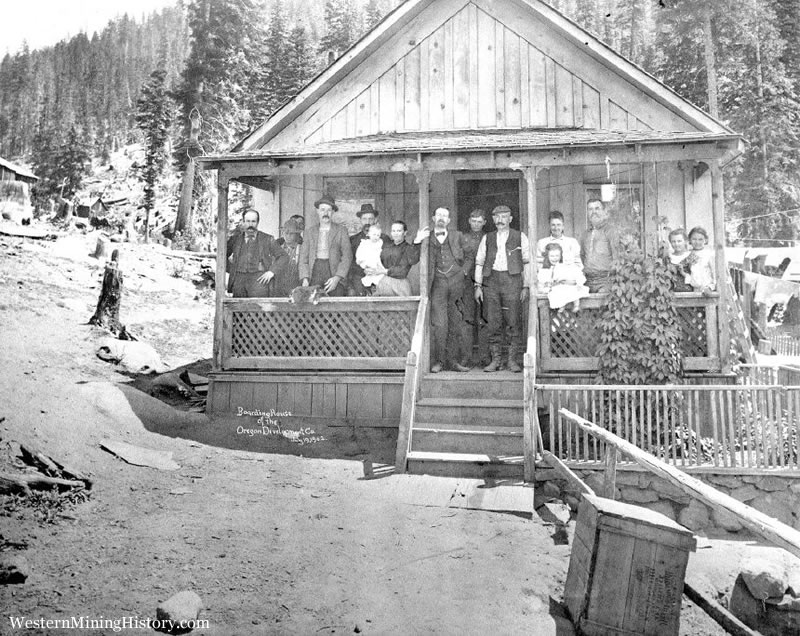
In the early 19th century many people’s homes were horrid. However, the industrial revolution eventually made homes more comfortable and healthier. Well off people lived in very comfortable houses. (Although their servants lived in cramped quarters, often in the attic). For the first time, furniture was mass-produced. That meant it was cheaper but unfortunately standards of design fell. To us, middle class 19th century homes would seem overcrowded with furniture, ornaments, and knick-knacks. However, only a small minority could afford this comfortable lifestyle.
In the early 19th century housing for the poor was dreadful. Often they lived in ‘back-to-backs’. These were houses of three (or sometimes only two) rooms, one of top of the other. The houses were literally back-to-back. The back of one house joined onto the back of another and they only had windows on one side. The bottom room was used as a living room and kitchen. The two rooms upstairs were used as bedrooms. The worst homes were cellar dwellings. These were one-room cellars. They were damp and poorly ventilated. The poorest people slept on piles of straw because they could not afford beds. Fortunately in the 1840s local councils passed by-laws banning cellar dwellings. They also banned any new back to backs. The old ones were gradually demolished and replaced over the following decades.
In the early 19th century skilled workers usually lived in ‘through houses’ i.e. ones that were not joined to the backs of other houses. Usually, they had two rooms downstairs and two upstairs. The downstairs front room was kept for best. The family kept their best furniture and ornaments in this room. They spent most of their time in the downstairs back room, which served as a kitchen and living room. As the 19th century passed more and more working class Victorians could afford this lifestyle.
Melville Bissell invented a carpet sweeper in 1876.
In the late 19th century workers houses greatly improved. After 1875 most towns passed building regulations which stated that e.g. new houses must be a certain distance apart, rooms must be of a certain size and have windows of a certain size. By the 1880s most working class people lived in houses with two rooms downstairs and two or even three bedrooms. Most had a small garden. At the end of the 19th century, some houses for skilled workers were built with the latest luxury – an indoor toilet.
A history of toilets
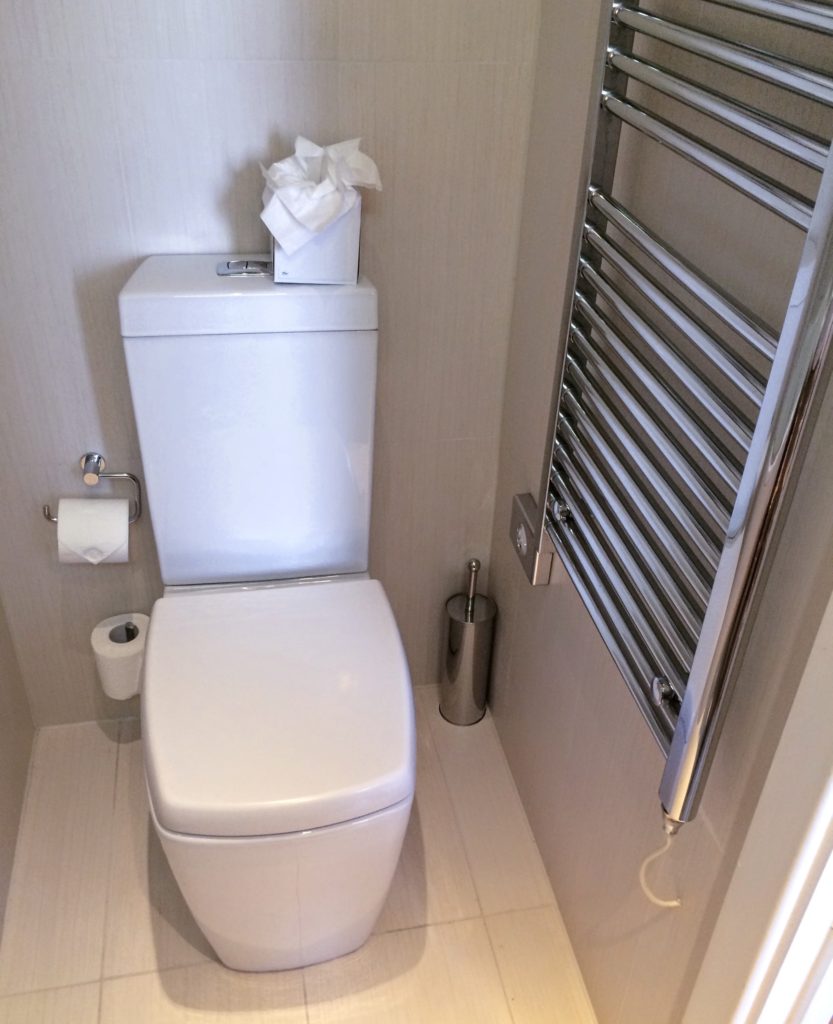
Most homes also had a scullery. In it was a ‘copper’, a metal container for heating water for washing clothes. The copper was filled with water and soap powder was added. To wash the clothes they were turned with a wooden tool called a dolly. Or you used a metal plunger with holes in it to push clothes up and down. Wet clothes were wrung through a wringer (also called a mangle) to dry them. (Robert Tasker invented the wringer in 1850).
At the beginning of the 19th century people cooked over an open fire. This was very wasteful as most of the heat went up the chimney. In the 1820s an iron cooker called a range was introduced. It was a much more efficient way of cooking because most of the heat was contained within. By the mid-19th century ranges were common. Most of them had a boiler behind the coal fire where water was heated.
However even at the end of the 19th century there were still many families living in one room. Old houses were sometimes divided up into separate dwellings. Sometimes if windows were broken slum landlords could not or would not replace them. So they were ‘repaired’ with paper. Or rags were stuffed into holes in the glass.
Gaslight first became common in well off people’s homes in the 1840s. By the late 1870s, most working class homes had gaslight, at least downstairs. Bedrooms might have oil lamps. Gas fires first became common in the 1880s. Gas cookers first became common in the 1890s. Joseph Swan invented the electric light bulb in 1878. However electric light was expensive and it took a long time to replace gas in people’s homes.
In the early 19th century only rich people had bathrooms. People did take baths but only a few people had actual rooms for washing. In the 1870s and 1880s, many middle class homes had bathrooms. The water was heated by gas. Working class people had a tin bath and washed in front of the kitchen range.
Transport during the Industrial Revolution
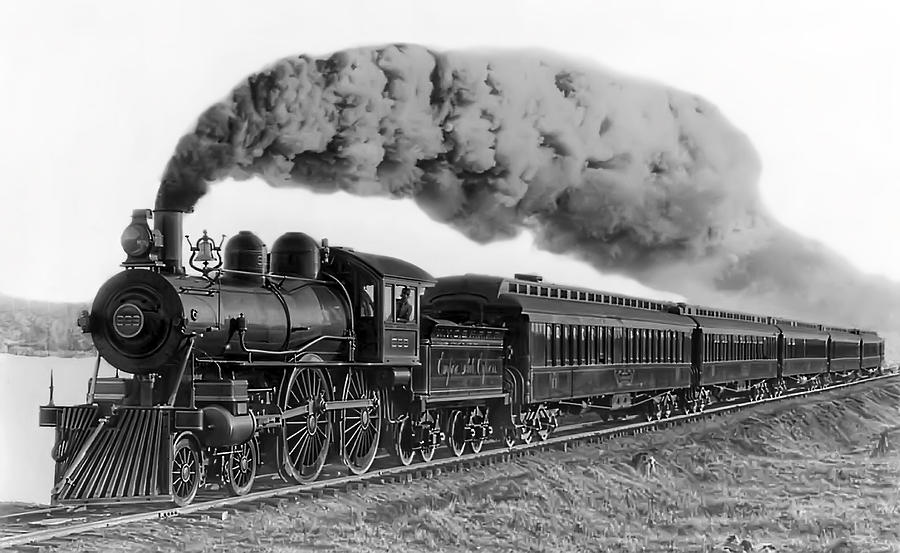
In the 19th century machines in factories were usually operated by steam engines. At the end of the 19th century they began to convert to electricity.
In the mid 19th century travel was revolutionised by railways. They made travel much faster. (They also removed the danger of highwaymen). The Stockton and Darlington railway opened in 1825. However, the first major railway was from Liverpool to Manchester. It opened in 1830. In the 1840s there was a huge boom in building railways and most towns in Britain were connected. The first underground railway in Britain was built in London in 1863. Steam locomotives pulled the carriages. The first electric underground trains began running in London in 1890.
Karl Benz and Gottlieb Daimler made the first cars in 1885 and 1886. Meanwhile at sea travel was revolutionised by the steam ship. By 1815 steamships were crossing the English Channel. Furthermore it used to take several weeks to cross the Atlantic. Then in 1838 a steamship called the Sirius made the journey in 19 days. However steam did not completely replace sail until the end of the 19th century when the steam turbine was used on ships.
Medicine during the Industrial Revolution

During the 19th century medicine made great advances. Louis Pasteur (1822-1895) proved that microscopic organisms caused disease. In the early 19th century many scientists believed in spontaneous generation i.e. that some living things spontaneously grew from non-living matter. In a series of experiments between 1857 and 1863 Pasteur proved this was not so. Once doctors what caused disease they made rapid headway in finding cures or prevention.
Surgery was greatly improved by the discovery of anaesthetics. As early as 1799 the inventor Humphry Davy (1778-1829) realized that inhaling ether relieved pain. Unfortunately, decades passed before it was actually used. An American dentist Henry H. Morgan began using ether in 1846. In the same year, ether was used as an anesthetic by surgeons.
Anaesthetics and antiseptics made surgery much safer. They allowed far more complicated operations. James Simpson (1811-1870), who was Professor of Midwifery at Edinburgh University, began using chloroform for operations in 1847. Incredibly some people disapproved of using chloroform to relieve pain, especially if it was used to help women giving birth. Some people thought that childbirth ought to be painful! However, in 1853 Queen Victoria insisted on having chloroform when she gave birth to her eighth child. Afterwards, most of the opposition to using chloroform ended. Nobody dared criticize the queen!
Anaesthetics and antiseptics made surgery much safer. They allowed far more complicated operations.In 1865 Joseph Lister (1827-1912) discovered antiseptic surgery, which enabled surgeons to perform many more complicated operations. Lister prevented infection by spraying carbolic acid over the patient during surgery. German surgeons developed a better method. The surgeons hands and clothes were sterilised before the operation and surgical instruments were sterilized with steam. Anaesthetics and antiseptics made surgery much safer. They allowed far more complicated operations. Rubber gloves were first used in surgery in 1890.
In 1851 Herman von Helmholtz invented the ophthalmoscope. The hypodermic syringe was invented in 1853. In 1895 Wilhelm Roentgen discovered x-rays. The same year aspirin was invented.
A history of medicine
During the 19th century people discovered new materials. Portland cement was invented in 1824. In 1839 Charles Goodyear discovered rubber vulcanization and celluloid was invented in 1869. In 1856 Henry Bessemer (1813-1898) invented the Bessemer converter, which converted iron to steel by blowing air through it while molten.
Meanwhile a whole host of inventions improved life for people during the 19th century. These included the lawn mower in 1830. Cyrus McCormick invented a mechanical reaper in 1831 and James Ritty invented the cash register in 1879. Other useful inventions were barbed wire by Joseph Glidden in 1873, the electric fan in 1882 and the fountain pen in 1884. In 1885 Donald Dewar invented the vacuum flask.
Warfare During the Industrial Revolution
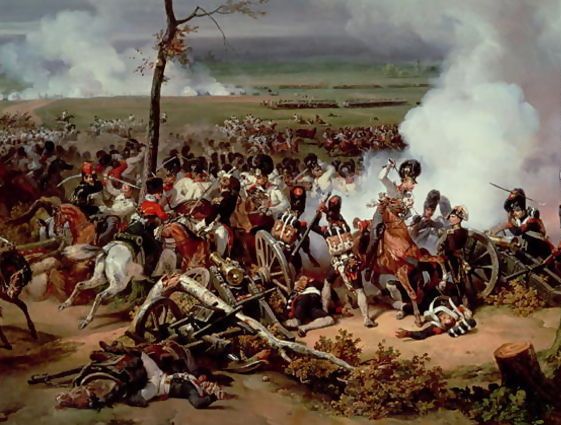
The industrial revolution transformed warfare. Railways meant armies could be transported much faster than before. The telegraph meant that messages could also be transmitted much faster. At the beginning of the 19th century Sir William Congreve (1772-1828) developed the Congreve rocket. These rockets were used at Copenhagen in 1807 and they set most of the town on fire. However rockets lacked both range and accuracy and after the Napoleonic Wars they fell from favor.
Meanwhile in 1807 a Scot named Alexander Forsyth patented the percussion cap. When a trigger was pulled a hammer hit a container of fulminate of mercury, which exploded and ignited the charge of gunpowder. The percussion cap replaced the flintlock. Breech loading guns greatly increased the rate of fire. The British army began using breech loading guns in 1865. The range of guns was improved by rifling. Some guns had been rifled for centuries but it only became commonplace in the 19th century. In the late 19th century rifles were improved further by the introduction of magazines, which greatly increased the rate of fire.
Meanwhile in 1836 Samuel Colt began making revolvers. Traditionally the cavalry fought with pistols and swords but the revolver made swords obsolete. In the 19th century many people experimented with machine guns. In 1862 Richard Gatling invented the Gatling gun. However the first really successful machine gun was the maxim gun, invented by Hiram Maxim in 1884. It was adopted by the British army in 1889.
War at sea was changed by exploding shells, by steam engines and by iron ships. In 1858 the French launched La Gloire. It was made with plates of iron fixed onto timber. However in 1860 Britain launched HMS warrior. This ship was made with an iron hull instead of a wooden hull with iron plates fixed on. Soon the traditional gun deck on warships was replaced by turret guns on the top deck. Then in the 1860s Robert Whitehead developed the modern torpedo. The British navy began making torpedoes in 1871.
In the 19th century new explosives were invented to replace gunpowder. TNT was invented in 1863 and dynamite followed in 1867. Cordite was invented in 1889.